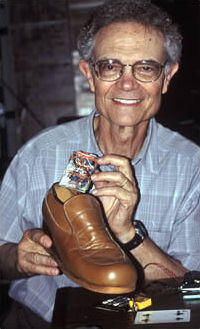James Grosjean
Most Blackjack players know about card counting, but the sequence of cards themselves isn’t the only factor that allows you to beat the house edge. James Grosjean was fascinated by gaming from childhood, learning how to win time and again in the tile-based game Mah Jong by using a humble Sinclair ZX80 computer to analyze the different playing strategies of his friends, and then crafting the optimum strategy for each one.
 By the time he had reached adulthood, he had developed strong analytical skills that he put to good use count cards in Blackjack. It was while playing cards one day that he noticed a careless dealer briefly revealing her hole card. After careful observation, he noticed that the dealer made this slip on a regular basis. Once again using his computer skills to analyze the possibilities, he worked out what the optimum play would be based on knowing the hole card. Armed with this new information, he went back to the same casino, and supposedly won 95% of his games against that dealer. He then jacked in his potential Wall Street career, and devoted himself to developing his ‘hole carding’ strategy, eventually using it across a string of casinos before putting his knowledge to use writing his successful (but now hard to find) book, ‘Beyond Counting’.
By the time he had reached adulthood, he had developed strong analytical skills that he put to good use count cards in Blackjack. It was while playing cards one day that he noticed a careless dealer briefly revealing her hole card. After careful observation, he noticed that the dealer made this slip on a regular basis. Once again using his computer skills to analyze the possibilities, he worked out what the optimum play would be based on knowing the hole card. Armed with this new information, he went back to the same casino, and supposedly won 95% of his games against that dealer. He then jacked in his potential Wall Street career, and devoted himself to developing his ‘hole carding’ strategy, eventually using it across a string of casinos before putting his knowledge to use writing his successful (but now hard to find) book, ‘Beyond Counting’.
Grosjean has also fought a strong fight for the rights of gamblers, and his lawsuits against Caesar’s Palace and Imperial Palace, and the security consultants Griffin Investigations, resulted in a Nevada court ruling that hole carding was a technique that could be legally used.
Keith Taft
 Grosjean may have made good use of early computers, but Keith Taft can rightly qualify as a true pioneer in the field of IT, crafting a Blackjack computer as early as 1970 – half a decade before the first proper home computers arrived on the market. The idea of this early project was to take the writings of Edward O Thorp (author of the hugely influential book ***), and to turn them into electronic form, creating a machine that could count cards far more successfully than Taft could himself. The computer consisted of several book-sized components fastened to his body, and his toes were used as the controls – one newspaper named him ‘The Fastest Toes in the West’. It initially worked well, before he lost over $6,000 after a poor run of cards.
Grosjean may have made good use of early computers, but Keith Taft can rightly qualify as a true pioneer in the field of IT, crafting a Blackjack computer as early as 1970 – half a decade before the first proper home computers arrived on the market. The idea of this early project was to take the writings of Edward O Thorp (author of the hugely influential book ***), and to turn them into electronic form, creating a machine that could count cards far more successfully than Taft could himself. The computer consisted of several book-sized components fastened to his body, and his toes were used as the controls – one newspaper named him ‘The Fastest Toes in the West’. It initially worked well, before he lost over $6,000 after a poor run of cards.
A more modern and easily portable version was created in the late 70s, and, realising that he was better at the technology than he was at the betting, Taft decided to introduce the device to another blackjack player – Ken Uston. At this time, Uston had only recently broken his partnership with Al Francesco, and was looking to create his own team of card counters. Powered by Taft’s technology, the new team refined their technique and skills. However, an unpromising initial run and a low percentage of the profits caused many of the team-members to become demotivated, and the team broke up soon after. Strangely, it was several of Taft’s children and in-laws who breathed new life into the enterprise, insisting that they could take the places of the original members. Heavily tutored by Uston, the new squad (now including Taft himself) took over $100K in a week.
Taft would come up against the casino authorities on several occasions, and the initial family team broke up after a series of heavy-handed ‘arrests’. Taft didn’t give up, though, and it was only when casinos made electronic devices illegal in the mid-80s that his plans were finally ended. The catalyst for the casino ban was another incident involving Taft and his family – or, specifically, his brother, who was arrested for having a mini video camera stored in his belt buckle. Taft’s attempts, then, may ultimately have fizzled out, but not before he did much to extend the use of technology, and to lay down in hard code and figures the optimum way of card-counting.
Zeljko Ranogajec

Born in Australia to Croatian parents, Ranogajec’s name is now known across the whole world. And yet, those who truly know of him are small in number, while the number who know the secrets of what he does are sparser still. Such has been the secrecy surrounding Ranogajec (he has been dubbed the Loch Ness Monster) that he has become almost a mythical player in the world of big-stakes gambling. Now possibly the largest of the large whales, the foundations of his empire were built upon blackjack. Starting off just a couple of hundred dollars, he used iron nerves and patience, finely-honed card-counting skills, and a willingness to exploit tiny percentage edges, to amass a multi-million fortune in the space of just a few years. First he conquered Australian casinos. Having been banned from almost every major outlet in that continent, he swept across the United States in similar fashion. Acknowledged as one of the greatest and most successful blackjack players of all time, he has been elected to the Blackjack Hall of Fame for his exploits. However, it’s not only blackjack where he has thrived. Indeed, he topped off his gaming winnings with a rumored $7.5 million win on Keno.
Having conquered much of the casino world, Ranogajec has since used his significant fortune to crack horse racing. Few details are available on his betting there, but it seems that he uses powerful computers to create huge amounts of data on each race, employing select teams to trawl through the data looking for badly priced horses. He particularly specializes in markets stuffed with ‘mug punter money’ (cash from casual horse players and members of the public), where poor value odds are often at their most frequent – and the juicy prices easiest to place big money on without sending the odds plummeting. Handsome rebates given to him by betting companies – who benefit by getting a nice portion of the huge funds his firm drops onto the markets – are an extra incentive. Whichever game he’s played in, Ranogajec seems to have been wildly successful, and is a convincing rebuttal of the claim that the house always wins.
